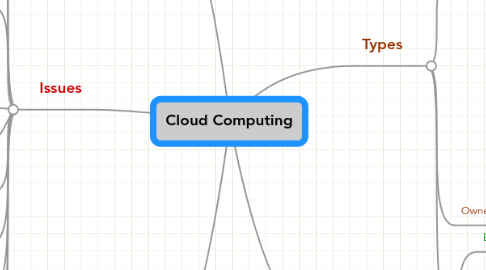
1. Drivers
1.1. Economic crisis (reluctance to invest)
1.2. Increased demand for mobililty
1.3. Increased demand for agility
1.4. CapEx to OpEx
2. Related topics
2.1. Virtualization
2.2. Grid computing
2.3. Mobile computing
2.3.1. Ubiquitous access
2.4. Utility computing
2.5. Data center
2.6. Information security
2.7. Information architecture
2.8. (Cloud) API's
3. Issues
3.1. Compliance & Regulations
3.1.1. Geographics
3.2. Security & Privacy
3.3. Vendor lock-in
3.4. Quality of Service / Reliability
3.4.1. Cloud provider
3.4.2. (Public) connections
3.4.2.1. Bandwidth
3.4.2.2. Speed
3.4.2.3. Uptime
3.4.3. In-house systems
3.5. Data and (legacy) (on-premise) system integration
3.6. Pricing
3.7. Data portability
3.7.1. Being able to get a copy of all data
3.7.2. Being able to delete all data
3.8. Data resilience (e.g. local data cache)
3.9. Getting different cloud environments and solutions to "play nice together"
3.10. Preventing cloud proliferation
3.10.1. Managing 'scale down' just as good as 'scale up'
3.11. Cloud provider abstraction (IaaS/PaaS)
4. Types
4.1. Service types
4.1.1. IaaS
4.1.1.1. Amazon EC2
4.1.1.2. Rackspace
4.1.2. PaaS
4.1.2.1. Application (aPaaS)
4.1.2.1.1. Force.com
4.1.2.2. Enabling (ePaaS)
4.1.2.2.1. Microsoft Azure
4.1.2.2.2. Google App engine
4.1.3. SaaS
4.1.3.1. CRM
4.1.3.1.1. SalesForce
4.1.3.2. Office
4.1.3.2.1. Office 365
4.1.3.2.2. Google Docs
4.1.3.3. E-mail
4.1.3.3.1. Gmail
4.1.3.4. Etc..
4.2. Ownership types
4.2.1. Private
4.2.2. Public
4.2.3. Hybrid
4.3. Compute types
4.3.1. Fabric
4.3.1.1. Google App engine
4.3.2. Instance
4.3.2.1. Amazon EC2
5. Benefits
5.1. Efficient use of resources
5.1.1. Energy saving
5.1.1.1. Less hardware idletime
5.1.1.2. More efficient cooling in data centers
5.2. Flexibility
5.2.1. Virtually unlimited storage
5.2.2. Virtually unlimited computing power
5.2.3. Increased mobility
5.2.4. Handle usage peaks more easily
5.3. Finances
5.3.1. Reduce costs / capital expenditure
5.3.2. Pay per use
